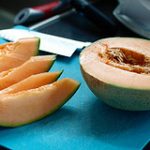
Melons
When to Buy/In Season:
April to November, depending on variety
How to Select:
Select fully ripened fruit for best sweetness and flavor. Avoid bruised or cracked melons. Ripe melons typically have a fruity aroma from the stem end. If the odor is faint, lightly scratch the surface of the stem area with a fingernail to reveal a fresh aroma. Remember, the fruit will taste like it smells, so avoid sour or bitter smelling fruit.
Cantaloupe and Muskmelons: Should be smooth at stem end, without any sign of stem remaining. The Rind around the blossom end should yield slightly to gentle pressure. The coarse, corky veining should stand out over the rind, which should not be green. Cantaloupes will ripen a few days on the kitchen counter. The rind should turn golden yellow when ripe.
Casaba should be golden yellow. The rind at the blossom end should yield slightly to gentle thumb pressure. Casabas should have no aroma.
Crenshaws should have a deep golden rind, sometimes with small areas of lighter yellow. The aroma should be pleasant.
Honeydew should be yellowish to creamy-white, with a soft, velvety feel. The aroma should be faint but pleasant.
Watermelons should be firm and symmetrically shaped. Flesh should be firm, of good red color with dark brown or black seeds. Avoid melons with white streaks running through the flesh. Watermelons are ripe when the light spot where they rested as they grew turns a yellowish color, and they sound hollow when gently thumped. A “flat” thump indicates a mushy melon.
Organic Issues:
Organic and conventional melons are both sprayed with sulfur to prevent mildew. However, nematode is a significant problem with melons, and toxic chemicals are used in conventional farming. Organic melons produced locally and vine-ripened are generally the best choice for flavor and quality.
Pesticide Issues:
EWG 2009 Dirty Dozen, Honeydew Melon is # 31; cantaloupe is #29, Watermelon is #36
How to Store:
Melons store well on the kitchen counter at room temperature, but will last refrigerated up to three weeks. Wrap fragrant melons tightly to prevent aromas being absorbed in other foods. After cutting melons, keep cut surfaces tightly covered and use within 2 – 3 days.
Cantalopes and Honeydew melons release ethylene, which can spoil some produce. Store these melons away from:
Bananas
Broccoli
Brussels sprouts
Cabbage
Carrots
Cauliflower
Cucumbers
Eggplant
Lettuce and other leafy greens
Parsley
Peas
Peppers
Squash
Sweet potatoes
Watermelon
Freezer
To Freeze Fresh Melon:
- Select firm-fleshed, well-colored, ripe melons. Cut in half, remove seeds and rind. Cut melons into slices, cubes or balls. Pack in freezer bags or containers.
Syrup Pack: Pack into containers and cover with cold 30 percent syrup. Leave headspace. Seal and freeze.
Unsweetened Pack: Pack into containers, leaving headspace. Seal and freeze.
- freeze melon (0F) 8 – 12 months
Photo Source: eddiewelker
Return to Buying and Storage Guide for Fruits


